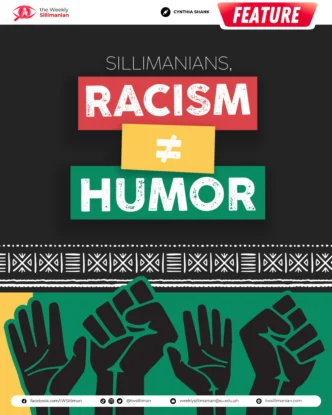By Danielle Bonior
They say that to truly know someone, you have to walk a mile in their shoes. But let’s be real—I’d rather walk a meter with their bags. Less tiring, more enlightening.
As a certified marites, I can’t help but wonder what life is like in other courses at Silliman University. If my everyday essentials include an arsenal of intermediate papers in every possible size—one whole, one half (horizontal and vertical, because why not?), and one-fourth—what’s in the bag of a Marine Biology student? A pet starfish (Patrick)? And for my “practicals” as a Medical Technology student, I have my trusty lab kit, but what about Geology students? What is in those massive bags? Rocks?
These are the questions that haunt me as I people-watch from the green benches at Nature, my go-to tamabayanan located between Ausejo Hall (AH) and the College of Computer Sciences (CCS).
Now, obviously, I can’t just go rifling through random Sillimanians’ bags—that’s technically a crime. But thankfully, being in the media has its perks. With the right pitch, I can ethically invade people’s privacy and publish it! (With consent, of course.)
And it’s not just students I got to snoop on. I also peeked into the bags of Sillimanian faculty and staff—because if anyone’s carrying the real essentials for survival in this university, it’s definitely them.
So Sillimanians, ever wondered what your fellow students and faculty carry in their bags? Here’s a peek into the everyday essentials—and surprises—they were willing to share.
Asst. Prof. Dina Remoto, faculty, College of Business Administration
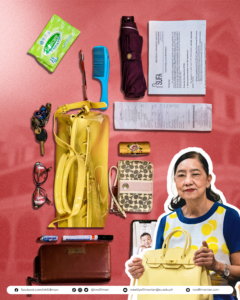
For Asst. Prof. Dina Remoto, some essentials are simply non-negotiable. While she jokes that she can live without her ID—”because my face is my ID”—there are three things she can’t go a day without. She always carries her keys—without them, she wouldn’t be able to get inside her house. Her cellphone is just as important, saying, “I cannot afford to leave my cellphone at home because my husband keeps calling me.” Lastly, her wallet is a must-have, holding her money, cards, and everything else she needs.
Arnel Sinda, 35 years old, Security Guard
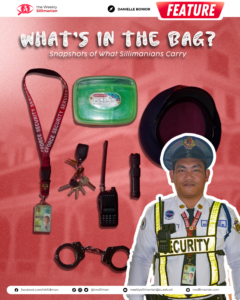
When asked what in his bag he values most, Arnel shares: “Akong balon kay akong misis ang nag handa. Siya ang mag andam tanan—kanang sa pagluto sa sud-an, sa rice. So ingana siya ka importante.”
(My lunchbox, because my wife is the one who prepares everything—she cooks and gets the rice ready. My lunchbox is important to me.)
Irish Labis, 25 years old, Juris Doctor III
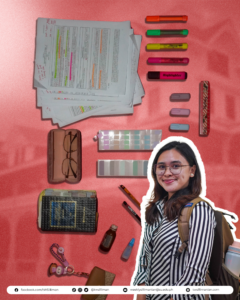
For Irish, the items in her bag keep her going through the worst of law school: “Haplas is very important, I think every law student naa gyuy haplas, kay we sleep really late at night and daghan na kaayo ming ginabati sa among body. It would also be codals—very important gyud siya. Without codals, kay murag di gyud ka ka survive sa law school. It’s like a Bible.”
(Ointment is very important, every law student has one. We sleep really late, and our bodies feel it. Also, the codals—very important. Without them, you can’t survive law school. It’s like a Bible.)
Ernst Rana, 25 years old, Doctor of Medicine III
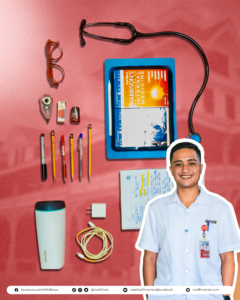
Ernst believes a tablet is an essential tool for anyone entering the field. With the rise of technology, he finds it to be a lighter and more convenient alternative to traditional textbooks. “Aside from textbooks, we are advised to read journals in medicine because it helps us further our readings, our education, and keep up to date with new advancements in technology,” he explains.
Jacob Desingco, 21 years old, Bachelor of Science in Marine Biology III
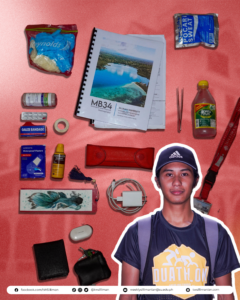
Jacob’s bag tells the tale of aquatic misadventures. Among his essentials is a bottle of Datu Puti vinegar, a must-have for marine biology students, “We often do fieldwork in the ocean or recreational activities after class. By the end of the day, someone usually gets stung by a jellyfish or steps on a sea urchin. Our first step is to get them out of the water and disinfect the wound. We can’t use harsh chemicals or just water, so we use vinegar—a milder acid that dissolves the spicules and prevents further damage from the sting.”
John Enopia, 24 years old, Bachelor of Science in Mechanical Engineering IV

John peppered his answer with the engineering brand of humour. When asked what every engineering student needs in their bag, he snickered: “Sh***, kay mabuang kas engineering. Bitaw, joke only.”
(Sh***, because engineering will drive you crazy. Just kidding, of course.)
Chessedh Villarin, 22 years old, Bachelor of Theology in Pastoral Ministry II
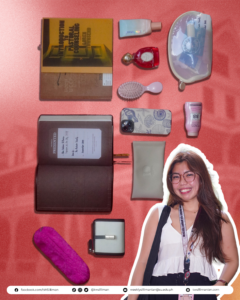
For Chessedh, her bag is a reflection of her personality more than her course. At the top of her essentials is her makeup bag—”I’m really kikay (girly), and I need to retouch all the time because we’re already stressed in this course, we can’t look so stressed,” she says. Perfume is another must-have, something she always carries with her. And, of course, the Bible holds a special place in her bag. “We’ll be studying all about God, and the Bible is the literature we use as a reference in our course,” she explains.
Athena Visitacion, 20 years old, Bachelor of Science in Foreign Affairs II
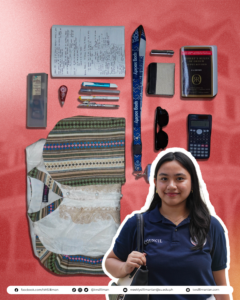
“Something unexpected in my bag would be the Filipiniana,” Athena shares. “You never know when the president is gonna come visit us or if there are any important guests—so you always need to have a Filipiniana in your bag.”
Julianne Gajonera, 20 years old, Bachelor of Science in Geology II
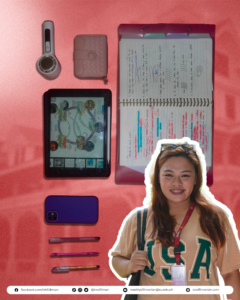
In Julianne’s case, what’s in her bag is a practical tool for beating the heat of fieldwork: “My portable fan. Knowing geology, we do fieldwork na bulad sa init, and of course with my fan, sige ra ko gatutok sa akong fan actually kay it’s so hot.”
(My portable fan. In Geology, we do fieldwork under the scorching sun, and I find myself constantly facing my fan because it’s just so hot.)
Naomi Saludar, 20 years old, Bachelor of Science in Nursing II
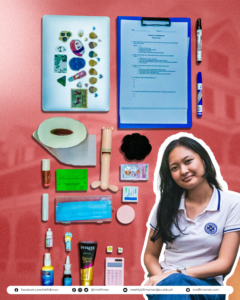
For Naomi, staying healthy isn’t just a priority—it’s a necessity. “I have throat and nasal spray because we have to be as healthy as we possibly can,” she says. She gets sore throats and allergies often, and the last thing she wants is to catch a cold before duty. “It takes its toll on your body when you’re going on an eight-hour shift, and it hurts to swallow.” With stress making her more vulnerable to sickness, she keeps the sprays on hand as a precaution whenever she starts feeling under the weather.
Jeckesa Tirambulo, 21 years old, Bachelor of Science in Psychology III
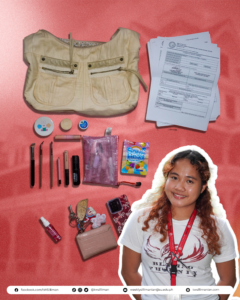
For Jeckesa, the contents of her bag say more about her habits than her course: “I think the trash reflects my personality kay ako man gud, when I go out, if I don’t see a trash bin, I put my trash either in my pocket or sa akong bag.” This is why there is always trash in her bag. An unexpected item since, as she says, she doesn’t know if other people are doing it.
(I think the trash. When I go out, if I don’t see a trash bin, I put it either in my pocket or in my bag. So there’s always trash in my bag.)
Gabrielle Caturay, 20 years old, Bachelor of Fine Arts in Studio Art II
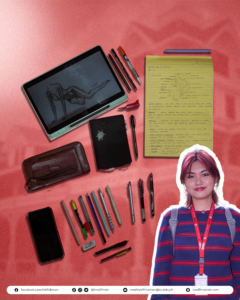
Gabrielle’s bag is a reminder of the journey she’s taken. Though now a Fine Arts student, she still carries notes about the eukaryotic cell on her yellow pad—a remnant of her time in Medical Technology. “One thing you wouldn’t have expected to find in my bag is my notes about the cell, written on my yellow pad,” she admits. While she has shifted to a more creative field, traces of her previous course remain in her belongings. “These notes remind me of my own unique academic journey—where I started and how my paths have shifted,” she reflects, seeing them as a testament to her perseverance and eagerness to keep learning.
–
After going through the bags of Sillimanians, it’s crystal clear that what we carry is more than just about function or aesthetics—it’s a snapshot of our lives.
A law student has a codal, ready for any legal challenge. A medical student always keeps their stethoscope close, a constant reminder of their duty. And a campus guard carries a packed lunch from his wife, a small comfort amid a busy day. Each item is a part of the story, from the practical to the personal, showing what matters most to each of us.
What we keep in our bags reflects more than just the tasks we need to complete; it shows the things that define our routines and our values.
So, the next time you reach for your bag, ask yourself: what does it say about you?

